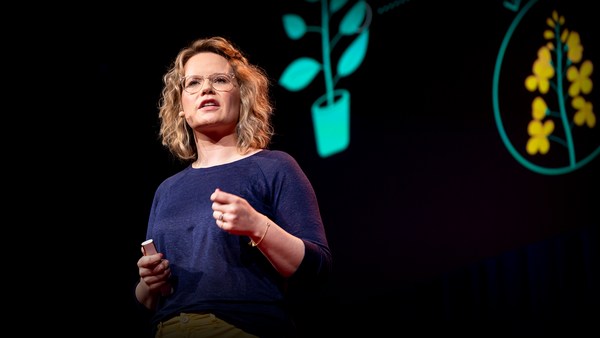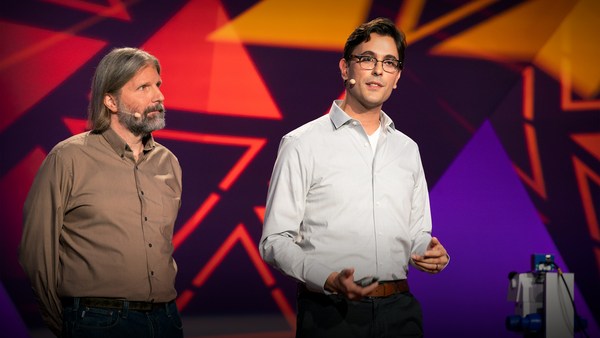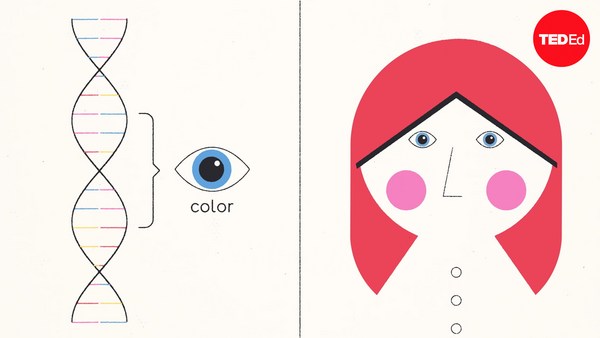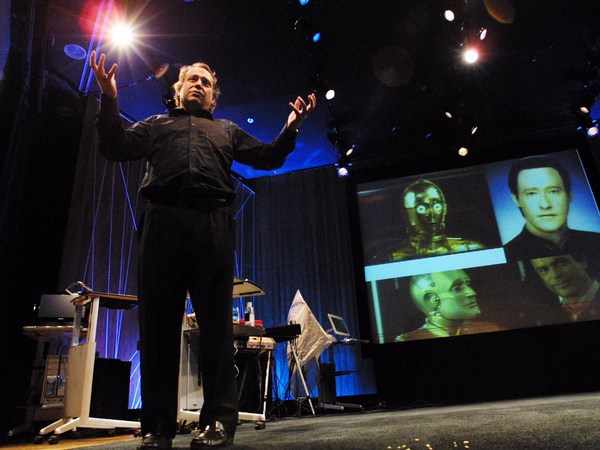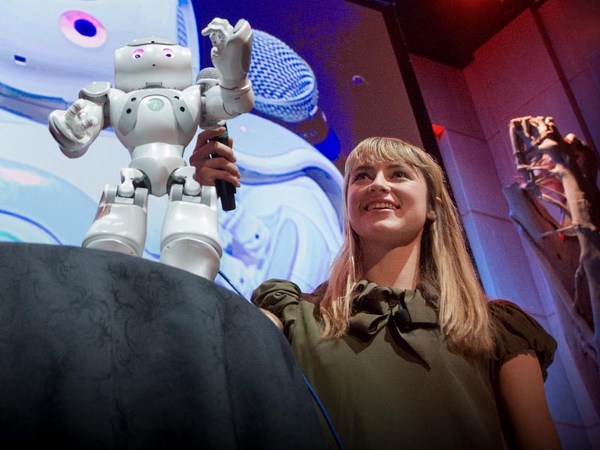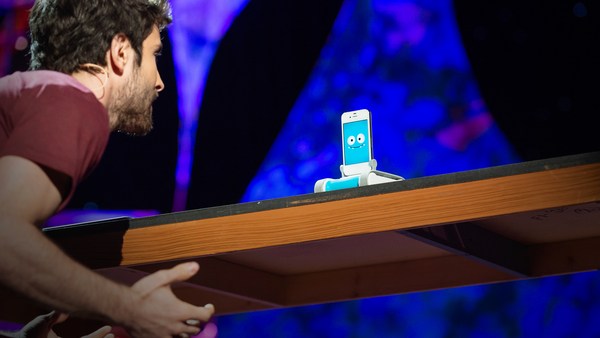Chris Anderson: Mike, welcome. It's good to see you. I'm excited for this conversation.
Michael Levin: Thank you so much. I'm so happy to be here.
CA: So, most of us have this mental model in biology that DNA is a property of every living thing, that it is kind of the software that builds the hardware of our body. That's how a lot of us think about this. That model leaves too many deep mysteries. Can you share with us some of those mysteries and also what tadpoles have to do with it?
ML: Sure. Yeah. I'd like to give you another perspective on this problem. One of the things that DNA does is specify the hardware of each cell. So the DNA tells every cell what proteins it's supposed to have. And so when you have tadpoles, for example, you see the kind of thing that most people think is sort of a progressive unrolling of the genome. Specific genes turn on and off, and a tadpole, as it becomes a frog, has to rearrange its face. So the eyes, the nostrils, the jaws -- everything has to move. And one way to think about it used to be that, well, you have a sort of hardwired set of movements where all of these things move around and then you get your frog. But actually, a few years ago, we found a pretty amazing phenomenon, which is that if you make so-called "Picasso frogs" -- these are tadpoles where the jaws might be off to the side, the eyes are up here, the nostrils are moved, so everything is shifted -- these tadpoles make largely normal frog faces. Now, this is amazing, because all of the organs start off in abnormal positions, and yet they still end up making a pretty good frog face. And so what it turns out is that this system, like many living systems, is not a hardwired set of movements, but actually works to reduce the error between what's going on now and what it knows is a correct frog face configuration.
This kind of decision-making that involves flexible responses to new circumstances, in other contexts, we would call this intelligence. And so what we need to understand now is not only the mechanisms by which these cells execute their movements and gene expression and so on, but we really have to understand the information flow: How do these cells cooperate with each other to build something large and to stop building when that specific structure is created? And these kinds of computations, not just the mechanisms, but the computations of anatomical control, are the future of biology.
CA: And so I guess the traditional model is that somehow cells are sending biochemical signals to each other that allow that development to happen the smart way. But you think there is something else at work. What is that?
ML: Well, cells certainly do communicate biochemically and via physical forces, but there's something else going on that's extremely interesting, and it's basically called bioelectricity, non-neural bioelectricity. So it turns out that all cells -- not just nerves, but all cells in your body -- communicate with each other using electrical signals. And what you're seeing here is a time-lapse video. For the first time, we are now able to eavesdrop on all of the electrical conversations that the cells are having with each other. So think about this. We're now watching -- This is an early frog embryo. This is about eight hours to 10 hours of development. And the colors are showing you actual electrical states that allow you to see all of the electrical software that's running on the genome-defined cellular hardware. And so these cells are basically communicating with each other who is going to be head, who is going to be tail, who is going to be left and right and make eyes and brain and so on. And so it is this software that allows these living systems to achieve specific goals, goals such as building an embryo or regenerating a limb for animals that do this, and the ability to see these electrical conversations gives us some really remarkable opportunities to target or to rewrite the goals towards which these living systems are operating.
CA: OK, so this is pretty radical. Let me see if I understand this. What you're saying is that when an organism starts to develop, as soon as a cell divides, electrical signals are shared between them. But as you get to, what, a hundred, a few hundred cells, that somehow these signals end up forming essentially like a computer program, a program that somehow includes all the information needed to tell that organism what its destiny is? Is that the right way to think about it?
ML: Yes, quite. Basically, what happens is that these cells, by forming electrical networks much like networks in the brain, they form electrical networks, and these networks process information including pattern memories. They include representation of large-scale anatomical structures where various organs will go, what the different axes of the animal -- front and back, head and tail -- are going to be, and these are literally held in the electrical circuits across large tissues in the same way that brains hold other kinds of memories and learning.
CA: So is this the right way to think about it? Because this seems to be such a big shift. I mean, when I first got a computer, I was in awe of the people who could do so-called "machine code," like the direct programming of individual bits in the computer. That was impossible for most mortals. To have a chance of controlling that computer, you'd have to program in a language, which was a vastly simpler way of making big-picture things happen. And if I understand you right, what you're saying is that most of biology today has sort of taken place trying to do the equivalent of machine code programming, of understanding the biochemical signals between individual cells, when, wait a sec, holy crap, there's this language going on, this electrical language, which, if you could understand that, that would give us a completely different set of insights into how organisms are developing. Is that metaphor basically right?
ML: Yeah, this is exactly right. So if you think about the way programming was done in the '40s, in order to get your computer to do something different, you would physically have to shift the wires around. So you'd have to go in there and rewire the hardware. You'd have to interact with the hardware directly, and all of your strategies for manipulating that machine would be at the level of the hardware. And the reason we have this now amazing technology revolution, information sciences and so on, is because computer science moved from a focus on the hardware on to understanding that if your hardware is good enough -- and I'm going to tell you that biological hardware is absolutely good enough -- then you can interact with your system not by tweaking or rewiring the hardware, but actually, you can take a step back and give it stimuli or inputs the way that you would give to a reprogrammable computer and cause the cellular network to do something completely different than it would otherwise have done. So the ability to see these bioelectrical signals is giving us an entry point directly into the software that guides large-scale anatomy, which is a very different approach to medicine than to rewiring specific pathways inside of every cell.
CA: And so in many ways, this is the amazingness of your work is that you're starting to crack the code of these electrical signals, and you've got an amazing demonstration of this in these flatworms. Tell us what's going on here.
ML: So this is a creature known as a planarian. They're flatworms. They're actually quite a complex creature. They have a true brain, lots of different organs and so on. And the amazing thing about these planaria is that they are highly, highly regenerative. So if you cut it into pieces -- in fact, over 200 pieces -- every piece will rebuild exactly what's needed to make a perfect little worm. So think about that. This is a system where every single piece knows exactly what a correct planarian looks like and builds the right organs in the right places and then stops. And that's one of the most amazing things about regeneration. So what we discovered is that if you cut it into three pieces and amputate the head and the tail and you just take this middle fragment, which is what you see here, amazingly, there is an electrical gradient, head to tail, that's generated that tells the piece where the heads and the tails go and in fact, how many heads or tails you're supposed to have. So what we learned to do is to manipulate this electrical gradient, and the important thing is that we don't apply electricity. What we do instead was we turned on and off the little transistors -- they're actual ion channel proteins -- that every cell natively uses to set up this electrical state. So now we have ways to turn them on and off, and when you do this, one of the things you can do is you can shift that circuit to a state that says no, build two heads, or in fact, build no heads. And what you're seeing here are real worms that have either two or no heads that result from this, because that electrical map is what the cells are using to decide what to do.
And so what you're seeing here are live two-headed worms. And, having generated these, we did a completely crazy experiment. You take one of these two-headed worms, and you chop off both heads, and you leave just the normal middle fragment. Now keep in mind, these animals have not been genomically edited. There's absolutely nothing different about their genomes. Their genome sequence is completely wild type. So you amputate the heads, you've got a nice normal fragment, and then you ask: In plain water, what is it going to do? And, of course, the standard paradigm would say, well, if you've gotten rid of this ectopic extra tissue, the genome is not edited so it should make a perfectly normal worm. And the amazing thing is that it is not what happens. These worms, when cut again and again, in the future, in plain water, they continue to regenerate as two-headed. Think about this. The pattern memory to which these animals will regenerate after damage has been permanently rewritten. And in fact, we can now write it back and send them back to being one-headed without any genomic editing. So this right here is telling you that the information structure that tells these worms how many heads they're supposed to have is not directly in the genome. It is in this additional bioelectric layer. Probably many other things are as well. And we now have the ability to rewrite it. And that, of course, is the key definition of memory. It has to be stable, long-term stable, and it has to be rewritable. And we are now beginning to crack this morphogenetic code to ask how is it that these tissues store a map of what to do and how we can go in and rewrite that map to new outcomes.
CA: I mean, that seems incredibly compelling evidence that DNA is just not controlling the actual final shape of these organisms, that there's this whole other thing going on, and, boy, if you could crack that code, what else could that lead to. By the way, just looking at these ones. What is life like for a two-headed flatworm? I mean, it seems like it's kind of a trade-off. The good news is you have this amazing three-dimensional view of the world, but the bad news is you have to poop through both of your mouths?
ML: So, the worms have these little tubes called pharynxes, and the tubes are sort of in the middle of the body, and they excrete through that. These animals are perfectly viable. They're completely happy, I think. The problem, however, is that the two heads don't cooperate all that well, and so they don't really eat very well. But if you manage to feed them by hand, they will go on forever, and in fact, you should know these worms are basically immortal. So these worms, because they are so highly regenerative, they have no age limit, and they're telling us that if we crack this secret of regeneration, which is not only growing new cells but knowing when to stop -- you see, this is absolutely crucial -- if you can continue to exert this really profound control over the three-dimensional structures that the cells are working towards, you could defeat aging as well as traumatic injury and things like this.
So one thing to keep in mind is that this ability to rewrite the large-scale anatomical structure of the body is not just a weird planarian trick. It's not just something that works in flatworms. What you're seeing here is a tadpole with an eye and a gut, and what we've done is turned on a very specific ion channel. So we basically just manipulated these little electrical transistors that are inside of cells, and we've imposed a state on some of these gut cells that's normally associated with building an eye. And as a result, what the cells do is they build an eye. These eyes are complete. They have optic nerve, lens, retina, all the same stuff that an eye is supposed to have. They can see, by the way, out of these eyes. And what you're seeing here is that by triggering eye-building subroutines in the physiological software of the body, you can very easily tell it to build a complex organ. And this is important for our biomedicine, because we don't know how to micromanage the construction of an eye. I think it's going to be a really long time before we can really bottom-up build things like eyes or hands and so on. But we don't need to, because the body already knows how to do it, and there are these subroutines that can be triggered by specific electrical patterns that we can find. And this is what we call "cracking the bioelectric code." We can make eyes. We can make extra limbs. Here's one of our five-legged tadpoles. We can make extra hearts. We're starting to crack the code to understand where are the subroutines in this software that we can trigger and build these complex organs long before we actually know how to micromanage the process at the cellular level.
CA: So as you've started to get to learn this electrical layer and what it can do, you've been able to create -- is it fair to say it's almost like a new, a novel life-form, called a xenobot? Talk to me about xenobots.
ML: Right. So if you think about this, this leads to a really strange prediction. If the cells are really willing to build towards a specific map, we could take genetically unaltered cells, and what you're seeing here is cells taken out of a frog body. They've coalesced in a way that asks them to re-envision their multicellularity. And what you see here is that when liberated from the rest of the body of the animal, they make these tiny little novel bodies that are, in terms of behavior, you can see they can move, they can run a maze. They are completely different from frogs or tadpoles. Frog cells, when asked to re-envision what kind of body they want to make, do something incredibly interesting. They use the hardware that their genetics gives them, for example, these little hairs, these little cilia that are normally used to redistribute mucus on the outside of a frog, those are genetically specified. But what these creatures did, because the cells are able to form novel kinds of bodies, they have figured out how to use these little cilia to instead row against the water, and now have locomotion. So not only can they move around, but they can, and here what you're seeing, is that these cells are coalescing together. Now they're starting to have conversations about what they are going to do. You can see here the flashes are these exchanges of information. Keep in mind, this is just skin. There is no nervous system. There is no brain. This is just skin. This is skin that has learned to make a new body and to explore its environment and move around. And they have spontaneous behaviors. You can see here where it's swimming down this maze. At this point, it decides to turn around and go back where it came from. So it has its own behavior, and this is a remarkable model system for several reasons. First of all, it shows us the amazing plasticity of cells that are genetically wild type. There is no genetic editing here. These are cells that are really prone to making some sort of functional body.
The second thing, and this was done in collaboration with Josh Bongard's lab at UVM, they modeled the structure of these things and evolved it in a virtual world. So this is literally -- on a computer, they modeled it on a computer. So this is literally the only organism that I know of on the face of this planet whose evolution took place not in the biosphere of the earth but inside a computer. So the individual cells have an evolutionary history, but this organism has never existed before. It was evolved in this virtual world, and then we went ahead and made it in the lab, and you can see this amazing plasticity. This is not only for making useful machines. You can imagine now programming these to go out into the environment and collect toxins and cleanup, or you could imagine ones made out of human cells that would go through your body and collect cancer cells or reshape arthritic joints, deliver pro-regenerative compounds, all kinds of things. But not only these useful applications -- this is an amazing sandbox for learning to communicate morphogenetic signals to cell collectives. So once we crack this, once we understand how these cells decide what to do, and then we're going to, of course, learn to rewrite that information, the next steps are great improvements in regenerative medicine, because we will then be able to tell cells to build healthy organs. And so this is now a really critical opportunity to learn to communicate with cell groups, not to micromanage them, not to force the hardware, to communicate and rewrite the goals that these cells are trying to accomplish.
CA: Well, it's mind-boggling stuff. Finally, Mike, give us just one other story about medicine that might be to come as you develop this understanding of how this bioelectric layer works.
ML: Yeah, this is incredibly exciting because, if you think about it, most of the problems of biomedicine -- birth defects, degenerative disease, aging, traumatic injury, even cancer -- all boil down to one thing: cells are not building what you would like them to build. And so if we understood how to communicate with these collectives and really rewrite their target morphologies, we would be able to normalize tumors, we would be able to repair birth defects, induce regeneration of limbs and other organs, and these are things we have already done in frog models. And so now the next really exciting step is to take this into mammalian cells and to really turn this into the next generation of regenerative medicine where we learn to address all of these biomedical needs by communicating with the cell collectives and rewriting their bioelectric pattern memories. And the final thing I'd like to say is that the importance of this field is not only for biomedicine. You see, this, as I started out by saying, this ability of cells in novel environments to build all kinds of things besides what their genome tells them is an example of intelligence, and biology has been intelligently solving problems long before brains came on the scene. And so this is also the beginnings of a new inspiration for machine learning that mimics the artificial intelligence of body cells, not just brains, for applications in computer intelligence.
CA: Mike Levin, thank you for your extraordinary work and for sharing it so compellingly with us. Thank you.
ML: Thank you so much. Thank you, Chris.
